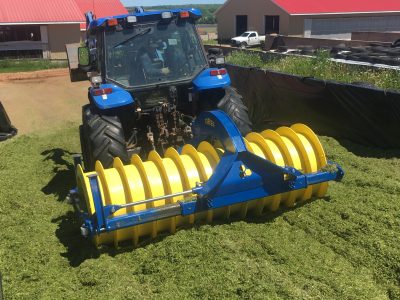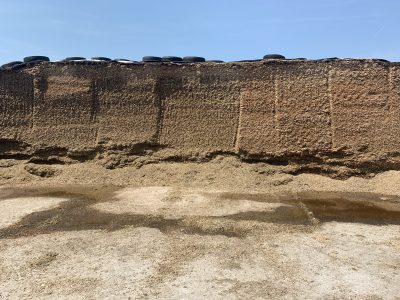



Eleven Ways To Avoid Feed Waste This Winter
Harvesting, storing and delivering a beef herd’s winter rations are the largest expense for most operations. Even small improvements in a winter feed system can result in significant feed cost savings.Whether a winter feed system uses a silage bunk or pit, baled forage, or swath grazing, significant feed waste losses can happen. Spoilage, mould, trampling, and weather are just a few examples of how losses can occur.

In addition to the expense of the feed lost, cow-calf operations can experience significant reproductive losses from spoiled or low-quality feed such as cows failing to rebreed the following breeding season and poor calf performance.
Feed testing can be the first step toward using stored feed efficiently. Once a plan is in place based on the feed test results, optimizing the consumption of the feed by limiting spoilage and wastage is a logical next step.
How to Limit Silage Waste
Reducing waste in silage starts in the field says Les Halliday, PhD, Beef Specialist at PEI Department of Agriculture and Land. Here are Les’ top tips to reduce silage waste:
- Use balers with knives. Les says coarse chopping allows for tighter packing of the forage in the bale resulting in less air and 10 -15% higher density which means less bales to wrap. Chopped grass in baled silage will also undergo a faster, more efficient fermentation than in regular baled silage. At feed out, cattle are able to access chopped silage more easily resulting in higher intake and less waste, however, Les cautions that if bales are too tight it can hinder cattle from physically eating the forage, and cause them to tire out.
- When wrapping silage bales in rows, ensure bales are consistent in size and shape. Wrapping bales that are the same size will reduce large air pockets that can form when bales are not consistent. He also strongly suggests, “if you’re going to try to cut your costs anywhere, don’t let it be your plastic.” The plastic wrap around silage bales creates a barrier from oxygen that is critical for good silage production. Without proper coverage, even a tiny hole (such as from rodents or barn cats) can lead to spoilage from mould.
- If storing chopped silage in a bunker system, packing density and a tight air seal is key. Les says higher packing density can be accomplished using a silage compaction roller which can increase packing density by as much as an additional 2 pounds of dry matter per cubic foot.
- Double seal bunks or use oxygen barriers. Double sealing or oxygen barrier plastic have shown positive results to reduce spoilage in bunks.
- Maintain a smooth silage bunk face to reduce secondary spoilage. An uneven bunk face, caused by feed removal, can result in a significant amount of air (oxygen) infiltration which wakes up the microbes that begin to use up nutrients (sugars, silage acids, and proteins) which leads to the production of carbon dioxide, ammonia and other gases. This can also lead to the growth of moulds, yeasts and certain pathogenic bacteria.
How to Reduce Waste in Dry Hay
According to Duane McCartney, a retired forage-beef systems research scientist at Lacombe, AB, limiting waste in dry hay also starts in the field.
- When cutting hay, set your mower on the widest setting. This will enable shorter drying time, lower respiration losses, higher sugar content, and more digestible energy. It also improves fermentation and reduces the likelihood of rain damage.
- When storing bales, arrange them to allow sufficient air flow. Where the bales touch, moisture can accumulate which can lead to spoilage losses. Duane also suggests that bales are stored in a well-drained area.
- Assess any leftover hay and straw bales that may need to be rearranged to ensure there is adequate air space around all the bales. Otherwise the summer rain will creep into the bales and spoilage will result.
- When feeding forages in round bale feeders, ensure each cow has enough space at the feeder to reduce competition and minimize trampled feed. Duane says he has observed the least waste in tapered cone style round bale feeders.
- Avoid feeding stored forages directly on the ground if possible. Whether it is chopped silage or round bales rolled onto snow, feed losses can range from 23-26%. Duane suggests a portable feed bunk can be a better option to reduce wasted feed.
 Swath grazing can be an effective method of feeding cattle; however, it requires planning to minimize feed waste. Duane suggests cattle be fenced into a small section that can be cleaned up ideally within three days. Not fencing off sections for swath grazing can result in an unbalanced diet and risk of acidosis. The accessibility of the swaths for the cattle may also need to be addressed. To open up areas in times of heavy snow, a tractor may be driven down the swath or a blade used to move snow off the swath. It is also important to provide adequate shelter, either through natural shelter or portable windbreaks, to prevent cattle from bedding down in the feed.
Swath grazing can be an effective method of feeding cattle; however, it requires planning to minimize feed waste. Duane suggests cattle be fenced into a small section that can be cleaned up ideally within three days. Not fencing off sections for swath grazing can result in an unbalanced diet and risk of acidosis. The accessibility of the swaths for the cattle may also need to be addressed. To open up areas in times of heavy snow, a tractor may be driven down the swath or a blade used to move snow off the swath. It is also important to provide adequate shelter, either through natural shelter or portable windbreaks, to prevent cattle from bedding down in the feed.
Regardless of the style of winter feeding, continually working to reduce feed waste and minimize the loss of nutrients protects your farm’s large investment in stored forage
.



